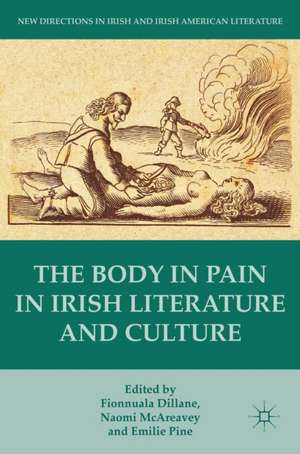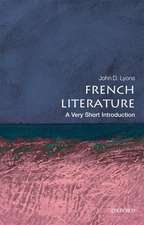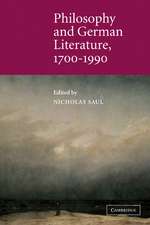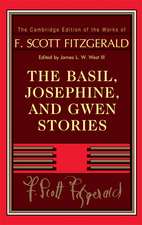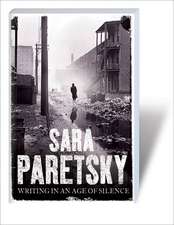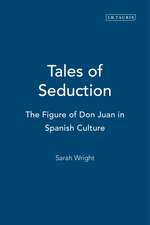The Body in Pain in Irish Literature and Culture: New Directions in Irish and Irish American Literature
Editat de Fionnuala Dillane, Naomi McAreavey, Emilie Pineen Limba Engleză Hardback – 16 dec 2016
This book elucidates the ways the pained and suffering body has been registered and mobilized in specifically Irish contexts across more than four hundred years of literature and culture. There is no singular approach to what pain means: the material addressed in this collection covers diverse cultural forms, from reports of battles and executions to stage and screen representations of sexual violence, produced in response to different historical circumstances in terms that confirm our understanding of how pain – whether endured or inflicted, witnessed or remediated – is culturally coded.
Pain is as open to ongoing redefinition as the Ireland that features in all of the essays gathered here. This collection offers new paradigms for understanding Ireland’s literary and cultural history.
| Toate formatele și edițiile | Preț | Express |
|---|---|---|
| Paperback (1) | 694.69 lei 6-8 săpt. | |
| Springer International Publishing – 11 iul 2018 | 694.69 lei 6-8 săpt. | |
| Hardback (1) | 701.40 lei 6-8 săpt. | |
| Springer International Publishing – 16 dec 2016 | 701.40 lei 6-8 săpt. |
Din seria New Directions in Irish and Irish American Literature
-
 Preț: 280.76 lei
Preț: 280.76 lei - 8%
 Preț: 591.76 lei
Preț: 591.76 lei - 15%
 Preț: 469.41 lei
Preț: 469.41 lei -
 Preț: 383.93 lei
Preț: 383.93 lei - 15%
 Preț: 642.03 lei
Preț: 642.03 lei - 15%
 Preț: 584.76 lei
Preț: 584.76 lei -
 Preț: 383.93 lei
Preț: 383.93 lei - 15%
 Preț: 695.70 lei
Preț: 695.70 lei -
 Preț: 388.72 lei
Preț: 388.72 lei -
 Preț: 384.09 lei
Preț: 384.09 lei - 15%
 Preț: 643.48 lei
Preț: 643.48 lei - 15%
 Preț: 640.06 lei
Preț: 640.06 lei - 15%
 Preț: 526.50 lei
Preț: 526.50 lei -
 Preț: 389.11 lei
Preț: 389.11 lei -
 Preț: 387.75 lei
Preț: 387.75 lei - 15%
 Preț: 470.06 lei
Preț: 470.06 lei -
 Preț: 387.75 lei
Preț: 387.75 lei - 15%
 Preț: 692.41 lei
Preț: 692.41 lei -
 Preț: 386.39 lei
Preț: 386.39 lei - 15%
 Preț: 586.05 lei
Preț: 586.05 lei - 18%
 Preț: 726.55 lei
Preț: 726.55 lei - 15%
 Preț: 499.77 lei
Preț: 499.77 lei -
 Preț: 175.38 lei
Preț: 175.38 lei - 18%
 Preț: 890.85 lei
Preț: 890.85 lei -
 Preț: 389.70 lei
Preț: 389.70 lei -
 Preț: 386.39 lei
Preț: 386.39 lei -
 Preț: 387.75 lei
Preț: 387.75 lei - 15%
 Preț: 637.59 lei
Preț: 637.59 lei - 15%
 Preț: 699.12 lei
Preț: 699.12 lei - 15%
 Preț: 472.36 lei
Preț: 472.36 lei -
 Preț: 386.39 lei
Preț: 386.39 lei -
 Preț: 390.25 lei
Preț: 390.25 lei
Preț: 701.40 lei
Preț vechi: 825.17 lei
-15% Nou
Puncte Express: 1052
Preț estimativ în valută:
134.21€ • 140.14$ • 110.83£
134.21€ • 140.14$ • 110.83£
Carte tipărită la comandă
Livrare economică 16-30 aprilie
Preluare comenzi: 021 569.72.76
Specificații
ISBN-13: 9783319313870
ISBN-10: 3319313878
Pagini: 323
Ilustrații: XVI, 283 p. 1 illus.
Dimensiuni: 148 x 210 x 22 mm
Greutate: 0.54 kg
Ediția:1st ed. 2016
Editura: Springer International Publishing
Colecția Palgrave Macmillan
Seria New Directions in Irish and Irish American Literature
Locul publicării:Cham, Switzerland
ISBN-10: 3319313878
Pagini: 323
Ilustrații: XVI, 283 p. 1 illus.
Dimensiuni: 148 x 210 x 22 mm
Greutate: 0.54 kg
Ediția:1st ed. 2016
Editura: Springer International Publishing
Colecția Palgrave Macmillan
Seria New Directions in Irish and Irish American Literature
Locul publicării:Cham, Switzerland
Cuprins
Introduction.- Introduction: The Body in Pain in Irish Literature and Culture; Fionnuala Dillane, Naomi McAreavey and Emilie Pine.- 1. Where Does It Hurt? How Pain Makes History in Early Modern Ireland; Patricia Palmer.- 2. 'Most barbarously and inhumaine maner butchered’: Masculinity, Trauma and Memory in Early Modern Ireland; Dianne Hall.- 3. ‘Those Savage Days of Memory’: John Temple and his Narrative of the 1641 Uprising; Sarah Covington.- 4. Severed Heads and Floggings: The Undermining of Oblivion in Ulster in the Aftermath of 1798; Guy Beiner.- 5. ‘Tá mé ag imeacht’: The Execution of Myles Joyce and its Afterlives; Margaret Kelleher.- 6. Pain, Trauma and Memory in the Irish War of Independence: Remembering and Contextualizing Irish Suffering; Ian Miller.- 7. Pain, Pleasure and Revolution: The Body in Roger Casement’s Writings; Michael G. Cronin.- 8.‘Targets of Shame’: Negotiating the Irish Female Migrant Experience in Kathleen Nevin’s You’ll Never Go Back (1946) and Kate O’Brien’s Mary Lavelle (1936); Sinéad Wall.- 9.‘Intertextual quotation’: Troubled Irish Bodies and Jewish Intertextual Memory in Colum McCann’s ‘Cathal’s Lake’ and ‘Hunger Strike’; Alison Garden.- 10. The Vulnerable Body on Stage: Reading Interpersonal Violence in Rape as Metaphor; Lisa Fitzpatrick.- 11. Recovery and Forgetting: Haunting Remains in Northern Irish Culture; Shane Alcobia Murphy.- 12. ‘That’s not so comfortable for you, is it?’: The Spectre of Misogyny in The Fall; Caroline Magennis.- 13. ‘The Art of Grief’: Irish Women’s Poetry of Loss and Healing; Catriona Clutterbuck.- Bibliography.- Index.
Recenzii
“It provides novel approaches to the study of the relationship between body, pain and historical memory. … It is undisputable that this book provides a valuable and interdisciplinary variety of theoretical and methodological approaches that fill a gap in bibliography about Irish cultural history.” (Shadia Abdel-Rahman Téllez, Review of Irish Studies in Europe – RISE, Vol. 2 (1-2), March, 2018)
Notă biografică
Fionnuala Dillane is Lecturer in Victorian Literature at University College Dublin, Ireland. She is author of Before George Eliot: Marian Evans in the Periodical Press, joint winner of the 2014 Robert and Vineta Colby Scholarly Book Prize.
Naomi McAreavey is Lecturer in Renaissance Literature at University College Dublin, Ireland. She has published widely on the 1641 rebellion, and her edition of The Letters of the First Duchess of Ormonde is forthcoming.
Emilie Pine is Lecturer in Modern Drama at University College Dublin, Ireland. She is the author of The Politics of Irish Memory (Palgrave, 2011), incoming Editor of the Irish University Review, and founding Director of the Irish Memory Studies Network.
Textul de pe ultima copertă
This book elucidates the ways the pained and suffering body has been registered and mobilized in specifically Irish contexts across more than four hundred years of literature and culture. There is no singular approach to what pain means: the material addressed in this collection covers diverse cultural forms, from reports of battles and executions to stage and screen representations of sexual violence, produced in response to different historical circumstances in terms that confirm our understanding of how pain – whether endured or inflicted, witnessed or remediated – is culturally coded.
Pain is as open to ongoing redefinition as the Ireland that features in all of the essays gathered here. This collection offers new paradigms for understanding Ireland’s literary and cultural history.
Caracteristici
Unique contribution to trauma studies due to Irish focus and conceptual rather than chronological approach Touches on aspects of affect studies and memory studies Examines work by a variety of canonical and contemporary writers, artists and political figures
